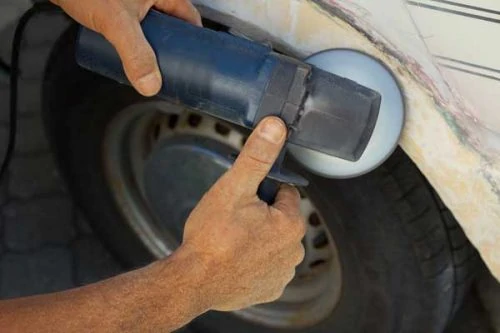Rusting is the most common problem with old cars. If you ever had it, you know how painful it feels to see such spot on your car’s body.
It is one of the most hated enemies of car owners. If someone lives in a cloudy, harsh cold, wet winter area; his car is prone to more chance of having rust on its body.
Rust holes repairing costs a healthy amount of money. But it does not necessitate to visit a repairman if you have the guts to fix it yourself.
Although it seems it must require a professional maintenance specialist, an average man can also take care of it.
Fix Rust Holes Using a Body Filler Kit
If your car has rust on it and you are looking for a solution, look no further. Follow our step by step instructions to fix rust holes on the car.
Prepare a Place
Fixing rust holes with body filler kit is the most common and easiest method that you can follow. Fix an appropriate place where you will work on it. It would be better if you choose a garage or anything of similar structure.
While working, anything can get dirty. So, anything that has a serious problem of being dirty should not be there in the first place.
Although you can fix rust with your hand, using an electric orbital sander will make the job easy for you. If you do not have it, rent one from a local hardware store.
You will need quite a few of sanding discs. These discs will be of 80, 120, 150, 240, 400-grit for different shaping purposes. You will also need a grinding wheel as well.
Your Safety Comes First
For any kind of workshop work, your safety comes first. Use eyeglasses or goggles to protect your eyes. This method of fixing will produce lots of airborne dust.
Therefore, wearing a surgical breathing mask is a must. Long shirt and pant is recommended to wear to protect the skin from sparks.
Prepare the Car and Materials
For masking everything that does not get painted, you will need masking paper and masking tape.If it is the primer that you will use, make sure to mask it as much as possible. There should be only few inches of space given to both sides of the rust spot.
If you want to match the body color, you might need to paint the entire panel for cleaner result. It is very hard to match paint within the body panel. Depending on the size of the panel, you will need to take approach.
Now It Is Fixing Time
First, you need to sand off the nearby paint of rusting spot. 80 and 150-grit sandpaper will do the work. If you can use a mechanical sander, it will be easy for you.
Next, it is time for grinding. You must grind away all the rust to fix the holes. Make sure you leave no rust. The spot will look like shiny metal from every edge if you grinded perfectly.
Make sure you are wearing goggles or glasses to protect your eyes from paint dust and metal.
Once the bare metal everywhere is easily visible, use the rust remover to remove all the rust.
With the help of a rust-resistant primer or converter, paint the border of the hole. It will convert the dust into the polymeric coating which will protect the metal and act as a primer. The protective coat leaves no room for the moisture to produce rust any further on the surface.
You will find these products in a form of spray and brush on. Depending on the manufacturer’s instructions, choose the appropriate one for you.
Using a small ball pen, tap the edges of each holes inwards. Hammer down to level the body panel. Now, the holes are ready for filling with body filler.
Mix body filler paste with hardener as per the kit instructions. If you add too much hardener, it will harden the mixture too quickly. To prepare a proper mixture, read the instructions.
You will find body filler in a local auto supply store. These kits contain a body filler paste, a piece of expanded metal (zinc), a fiberglass cloth to support while patching the hole, and of course a hardener.
Hold the zinc metal piece from behind the hole. Attach it to the body from behind the hole with a small amount of filler. It will make the body filler paste stable.
Apply body filler to the holes with the plastic applicator provided with the package. The holes need to be adequately filled, use more filler if necessary. Contour the paste to the car’s body.
Now, let the filler dry. How long you have to wait? Read the instructions, it is written on there. When it is dried, Use, 180-grit sandpaper to make it smooth.
Also, sand it down matching to the level of rest of the body panel. But this time, go with 120 or 150-grit sandpaper and make it smoother. Go slowly, make sure you do not take off too much of the body.
At this stage, you should use primer to make sure the rust does not make its way back. Use 240-grit sandpaper to sand even more smoothly. You can use an electric sander if you want.
Clean off the dust, make sure it is completely dried before painting. Spray a very thin layer of primer. You will need another two or three coat at least. Let it dry and sand for the smoothness. After doing it for two or three times, then move on to the paintwork.
With 400-grit sandpaper, make the surface even smoother before starting the paint. Do not use an electric sander here. When the surface is dust free and dry, start painting.
While painting, do not make it excessive thick or drips. Use long even strokes and go for a thin layer coating. When finished, it is time for sanding it with 400-grit sandpaper again. Sand down any drips and thick spots.
Continue cleaning and dry the repair. Then sand in between process after finishing three coats. When you are at your final sanding, take 400-grit sandpaper and make sure it is wet (water only) and sand for the last time.
The final clear coat layer will preserve the other layers while giving it a smooth and glossy look.
Frequently Asked Questions
1. What is rust?
It is important to know about rust before jumping into the fix, so that next time you do not have to face the issue any further. Rust is a common corrosion of metal when the metal, iron comes to the conduct of water and oxygen.
2. Why does it cause to cars?
The typical case of having rust on cars is because of exposing the car’s metal body to water. New cars these days come with a steel coated body on top of the metal to prevent rusting or slowing down the process of it. But unfortunately, rusting does occur even in new cars.
3. Why a car rusts faster in seaside locations?
Cars in the coastal areas are more vulnerable to rusting due to the moist air. Rusting not always happens only due to water and oxygen. The density of water in the air of the moist areas is more than the dry areas, followed by salt from the ocean. Water and salt is enough for the rusting to occur.
4. What can you do to protect your car if you live in a seaside area?
If someone lives in a seaside area, he cannot help his car from rusting. All he can do is delaying it. New cars these days come with a specific coat that prevents the cars from rusting to some extent.
However, there are few things to do that can actually help you deal with this problem.
Frequently wash your car, get a professional rust-proofing, wax the car regularly (at least twice a year), and also whenever there is any dent or scratch, make sure you seal that as soon as possible.
Additionally, the undercarriage should be washed. To neutralize road salt, use baking soda.
5. Do new cars rust?
Even though new cars come with rust-proof coating, the reality is quite different. The dust-proof coating from the manufacturer is not enough to prevent it from rusting.
Therefore, after-market professional rust-proofing must be done before the rust appears and winter approaches.
Final Words
We understand, you take a good care of your car. Nobody likes to see even minor scratches on their car’s body.
Although we cannot avoid our cars from rusting permanently, we can prevent it from happening if we invest some extra efforts and money on our cars.
Hopefully, this article helps you to minimize the effects of rusting on your car.

Myself Erick R. Jackson, I am a Computer Science graduate by law but a passionately enchanted blogger by profession.
A few years back, it all started with my first blog website. It was about to deal and heal with automotive hand tools. Well, it brought me a good audience base for sure, which then dragged me out of my major and got me to sit and write, and be a blogger. Read more

